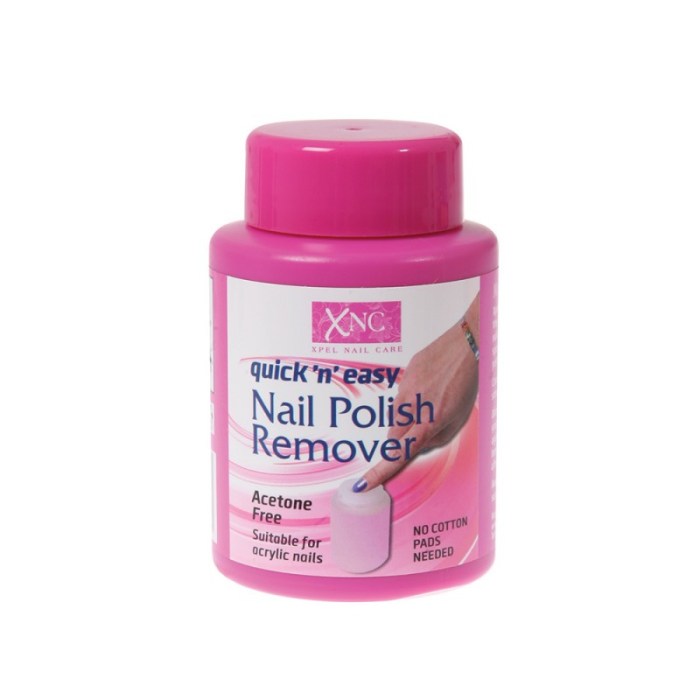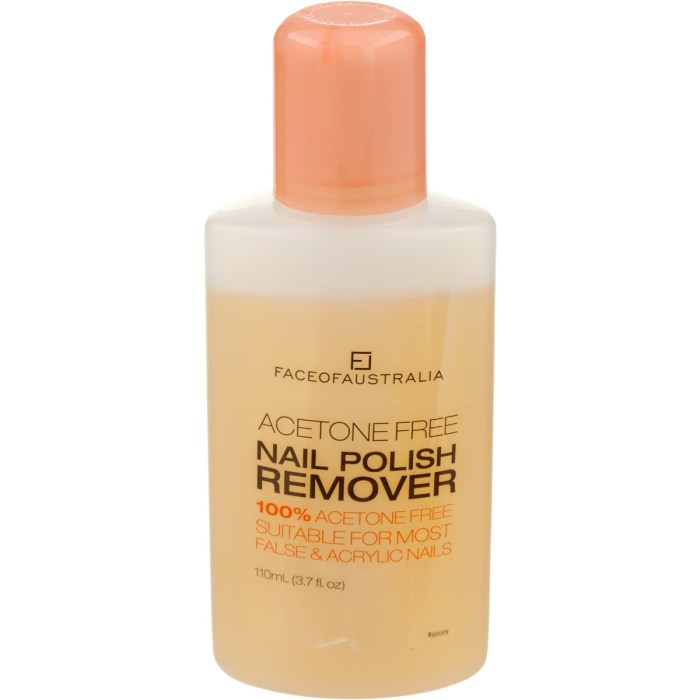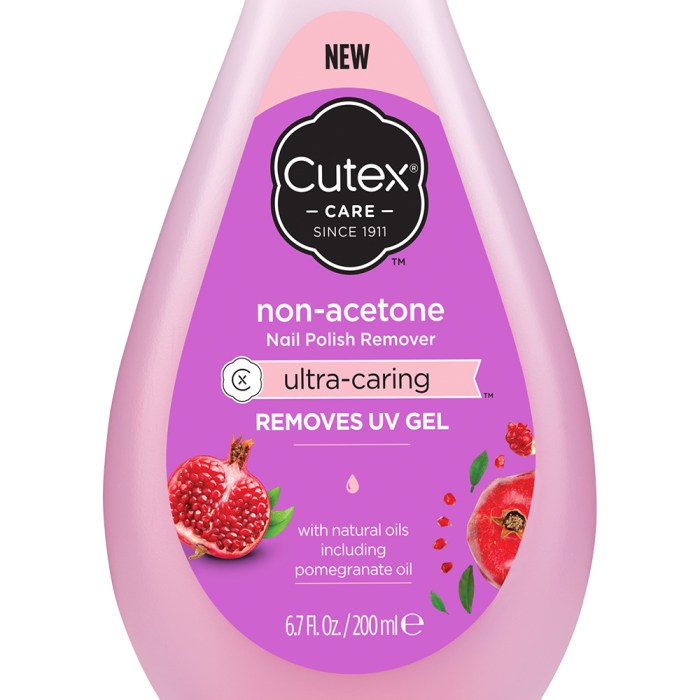Nail Polish Remover No Acetone A Comprehensive Guide
Understanding Acetone-Free Nail Polish Remover
Nail polish remover no acetone – Acetone-free nail polish removers offer a gentler alternative to traditional formulas, prioritizing nail and skin health. This article delves into the composition, effectiveness, and environmental impact of these removers, providing a comprehensive guide for informed consumer choices.
Chemical Composition of Acetone-Free Removers
Unlike acetone-based removers which rely on acetone (propan-2-one) as the primary solvent for dissolving nail polish, acetone-free versions utilize different solvents. These often include ethyl acetate, butyl acetate, or a blend of various esters. These esters are generally considered less harsh than acetone, but their effectiveness can vary.
Types of Solvents in Acetone-Free Formulations, Nail polish remover no acetone
Several solvents are commonly employed in acetone-free nail polish removers. Ethyl acetate is a common choice, known for its relatively quick evaporation rate and effectiveness on many nail polish types. Butyl acetate is another frequent ingredient, offering a slightly slower evaporation rate and potentially gentler action on nails. Some formulations combine multiple solvents to optimize both effectiveness and gentleness.
Comparison of Acetone-Based vs. Acetone-Free Removers
| Solvent Type | Effectiveness | Nail Health Impact | Environmental Impact |
|---|---|---|---|
| Acetone | High, particularly effective on long-lasting and gel polishes | Can be drying and potentially damaging to nails with prolonged use. | Volatile organic compound (VOC) with potential for air pollution. |
| Ethyl Acetate & Butyl Acetate | Generally lower than acetone, effectiveness varies depending on nail polish type and formulation. | Generally less drying than acetone, but still potential for dryness with frequent use. | Lower VOC content compared to acetone, but still requires responsible disposal. |
Effectiveness and Application Methods: Nail Polish Remover No Acetone
The effectiveness of acetone-free removers can depend on several factors, including the type of nail polish, the formulation of the remover, and the application method. Optimizing the application process is key to achieving satisfactory results.
Effectiveness on Different Nail Polish Types

Source: luxplus.photos
Acetone-free removers are generally less effective on long-lasting and gel polishes compared to acetone-based removers. Regular nail polishes are usually removed more easily, though soaking times may be longer. For stubborn polishes, additional techniques might be necessary.
Optimal Application Methods
To maximize effectiveness, saturate a cotton pad generously with the remover and hold it firmly against the nail for the recommended soaking time (usually 1-2 minutes). Gentle rubbing can assist in the process, but avoid harsh scrubbing, which can damage nails.
Tips for Removing Stubborn Nail Polish
For difficult-to-remove polish, try increasing the soaking time, applying multiple layers of saturated cotton pads, or using a cuticle pusher to gently loosen the polish from the edges. Pre-softening the polish with a warm, soapy soak can also help.
Step-by-Step Guide to Using Acetone-Free Remover

Source: com.au
- Apply a generous amount of acetone-free remover to a cotton pad.
- Hold the saturated cotton pad firmly against your nail for 1-2 minutes, or as directed on the product label.
- Gently wipe the nail polish away, using a fresh cotton pad if necessary.
- Repeat the process until all polish is removed.
- Wash your hands thoroughly with mild soap and water.
- Apply a nourishing cuticle oil or hand cream to moisturize your nails and skin.
Impact on Nails and Skin
While acetone-free removers are generally gentler than their acetone-containing counterparts, they can still have an impact on nail health and skin. Understanding these potential effects allows for informed product selection and responsible use.
Potential Effects on Nail Health
Even though less harsh than acetone, frequent use of acetone-free removers can still lead to some degree of dryness and brittleness. Regular moisturizing and conditioning are crucial to mitigate these effects. The specific impact can also depend on the solvents used in the formulation.
Impact of Different Solvents on Skin
Different solvents in acetone-free formulations can have varying effects on the skin. Some individuals may experience mild irritation or dryness with certain solvents. Patch testing a small area of skin before full application is advisable for sensitive individuals.
Allergic Reactions and Skin Irritation
The potential for allergic reactions or skin irritation exists with both acetone-based and acetone-free removers, although it is generally considered lower with acetone-free options. Ingredients such as fragrances or added moisturizers can be potential irritants for some individuals.
Environmental Considerations
The environmental impact of nail polish removers is a growing concern. Understanding the differences between acetone-based and acetone-free formulations in this context allows consumers to make more sustainable choices.
Environmental Impact of Production and Disposal
The production of both acetone-based and acetone-free removers involves the manufacturing and transportation of ingredients and packaging, contributing to carbon emissions. Disposal of the products and packaging also adds to the environmental burden. However, acetone-free removers generally have a lower VOC content, reducing air pollution.
Comparison of Environmental Footprints
Acetone-free removers generally have a smaller environmental footprint than acetone-based removers due to the lower VOC content of their solvents. However, the packaging materials and overall manufacturing process still contribute to the environmental impact. Choosing products with recyclable packaging is one way to reduce this impact.
Eco-Friendly and Sustainable Options
Several brands are now offering eco-friendly and sustainable acetone-free nail polish removers. These products often utilize plant-based solvents, recyclable packaging, and minimize their carbon footprint throughout the production and distribution process.
Ingredient Analysis and Selection
Understanding the ingredients in acetone-free nail polish removers is crucial for making informed choices that prioritize both effectiveness and gentleness. This section explores common ingredients and the characteristics of ideal formulations.
Common Ingredients and Their Functions
Common ingredients include ethyl acetate (solvent), butyl acetate (solvent), water (solvent and carrier), glycerin (moisturizer), and various fragrances and preservatives. The specific blend of ingredients determines the effectiveness and gentleness of the remover.
Characteristics of Ideal Ingredients
An ideal acetone-free remover should effectively remove nail polish without excessive drying or irritation. This requires a balance of effective solvents and gentle moisturizing agents. Avoiding harsh chemicals and prioritizing natural or sustainably sourced ingredients is also desirable.
Hypothetical Label for an Acetone-Free Nail Polish Remover

Source: wilko.com
A hypothetical label might highlight ingredients such as “Ethyl Acetate (plant-derived), Glycerin (moisturizing), and Aloe Vera Extract (soothing).” The label could also emphasize the product’s cruelty-free status, eco-friendly packaging, and its gentle formulation.
Product Recommendations and Reviews
Several brands offer high-quality acetone-free nail polish removers. This section provides examples of popular products and summarizes customer reviews to assist in making informed purchasing decisions.
Popular Brands and Products
Many brands, including those focusing on natural and organic beauty products, offer acetone-free options. Specific product names and details would need to be sourced from current market offerings.
Acetone-free nail polish remover is a gentler option for many surfaces, but sometimes more robust methods are needed. If you’ve accidentally gotten nail polish on your wooden furniture, for instance, you might need a stronger approach; check out this helpful guide on how do you remove nail polish from wood to find the best solution. However, for delicate items or a less aggressive cleaning, remember that acetone-free remover is often the preferred choice.
Comparative Chart of Acetone-Free Remover Brands
| Brand | Product Name | Key Features | User Reviews Summary |
|---|---|---|---|
| [Brand Name 1] | [Product Name 1] | [Key Features 1] | [Summary of User Reviews 1] |
| [Brand Name 2] | [Product Name 2] | [Key Features 2] | [Summary of User Reviews 2] |
DIY Acetone-Free Remover Recipes
Creating your own acetone-free nail polish remover allows for greater control over ingredients and cost-effectiveness. However, safety precautions must be observed when handling certain household chemicals.
Homemade Acetone-Free Remover Recipes
- Recipe 1: Mix equal parts of ethyl acetate (available at some pharmacies or online) and moisturizing oil (e.g., jojoba or olive oil). This recipe balances solvent strength with skin conditioning.
- Recipe 2: Combine 1/4 cup of rubbing alcohol (isopropyl alcohol), 1 tablespoon of white vinegar, and 1 tablespoon of warm water. This recipe is more effective on regular nail polish but may be less moisturizing.
- Recipe 3: Use a combination of warm water, a small amount of mild dish soap, and a few drops of essential oil (e.g., lavender or tea tree oil) for a gentle and naturally scented remover. This is best for removing very light or easily removable nail polish.
Safety Precautions for Homemade Removers
Always test a small area of skin before applying any homemade remover to your nails to check for allergic reactions. Ensure adequate ventilation when using volatile solvents. Avoid contact with eyes and keep out of reach of children.
Essential FAQs
What are the best brands of acetone-free nail polish remover?
Several brands offer effective acetone-free removers, including but not limited to: [List specific brands here]. Consumer reviews should be considered when making a purchase.
Can acetone-free remover damage artificial nails?
The effect on artificial nails varies depending on the type of artificial nail and the specific ingredients in the remover. Always test a small area first. Some formulations may be gentler than others.
How often should I use acetone-free nail polish remover?
Only remove polish when necessary. Overuse of any nail polish remover can dry out nails, regardless of whether it contains acetone.
Are there any potential health risks associated with ingredients in acetone-free removers?
While generally considered safer than acetone, some ingredients in acetone-free removers may cause skin irritation or allergic reactions in sensitive individuals. Always check the ingredient list and patch test before widespread use.
















